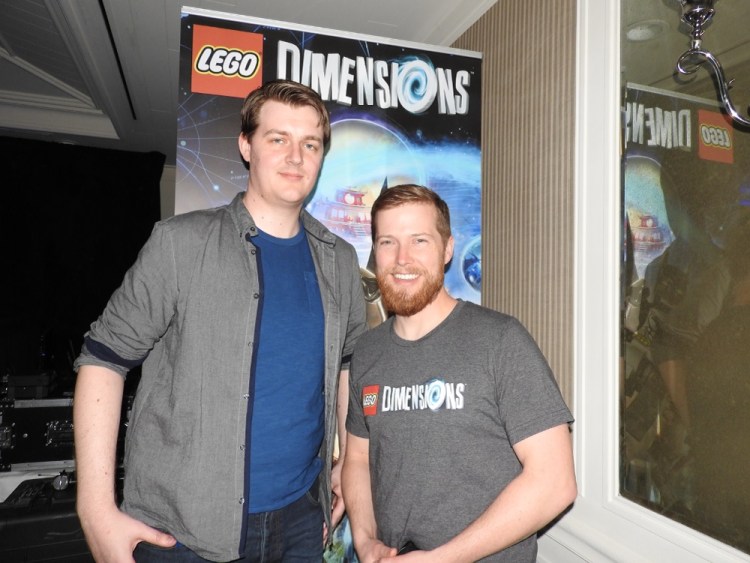Warner Bros. bought TT Games, the maker of Lego video games, about eight years ago. And all that time, it was working on something big: a convergence of video games and toys, according to Jon Burton, managing director of TT Games.
The result is Lego Dimensions, the latest entry in the “toys-to-life” category that ties together video games and toys — and has generated revenues to date of $4 billion. Lego Dimensions debuts on Sept. 27, but we got a sneak preview of the gameplay and talked with two of the people working on it, Doug Heder, producer at Warner Bros. Interactive Entertainment, and Mark Warburton, associate producer at TT Games.
David Haddad, the head of Warner Bros. Interactive Entertainment, said in a fireside chat at our GamesBeat Summit event that Lego Dimensions is one of the biggest investments his company is making in games, and they would only attempt it because of the long history they’ve had making Lego games that have sold tens of millions of units.
Warner is chasing rivals who beat it to market. That includes Activision with Skylanders, Nintendo with Amiibo, and even Rovio with Angry Birds. But it is trying to innovate in the category, starting with the fact that you can customize some of the objects in the game as you wish, in Lego fashion. With Lego Dimensions, you build a portal from Lego bricks and connect it to a video game system. You set characters on the portal in order to play them in the game.
Warner’s game will include characters from Back to the Future, DC Comics, The Lord of the Rings, The Lego Movie, The Simpsons, Doctor Who, Ghostbusters, Portal, Jurassic World, Midway Arcade, Lego Chima and Scooby-Doo!
Here’s an edited transcript of our conversation with Heder and Warburton.
GamesBeat: So was this a year making the game and seven years of lawyers arguing with each other?
Doug Heder: Honestly, the lawyering part of it was the shorter end of that equation. It was really coming up with this kernel of an idea that John had and building that into something that could make a mark in the space, make a difference, really change that toys-to-life category.
GamesBeat: What were some of the things that had to get ready in that time? Was the toy technology something you saw change a lot?
Heder: There’s the toy technology, for sure, being able to create more than a spawning device. We wanted to make it an integral part of the gameplay design, have that become as much a toy as any of the other toys in the gameplay experience. It took some time. A lot of work went into figuring out how that would work, trying out pieces and seeing what that meant gameplay-wise. Okay, scrap that, start over. A lot of R&D went into that process.
GamesBeat: Was it the electronics in the toys that got better, the RFID and so on?
Mark Warburton: We did need to wait for technology to catch up. The toys-to-life category exploded over the past couple of years. We could have just said, “Okay, let’s go out there and do a version of our game that uses this button.” That sold us short and sold fans short.
We wanted to go from the ground up and make the best gameplay experience we could possibly offer. That meant designing the hardware as close to John’s vision as we could get it, making sure the hardware and game design were integrated perfectly, so there’s this seamless experience between digital and physical play. That’s the tentpole of this project.
GamesBeat: The red light flashing while something’s happening in the game, that certainly seems like something no one else has done yet. Was it a matter of coming up with the idea, or were you waiting for the technology there?
Warburton: It’s a little bit of both. We didn’t want it to just be a spawning device, as I said. That would have been the simple route. We want you to sit down in front of your TV with your game and your controller, but also do your thinking with the toy pad as well. The more play you do with both, the more exciting it gets.
GamesBeat: When you got access to all of these characters, how did you decide what would be a fun thing to do with them?
Warburton: A lot of it comes from the designers. They have ideas coming out everywhere. They sit in rooms and thrash out ideas left, right, and center. There’s probably mountains of rubbish paper in the background of all these ideas. The cool thing is, the more IP we get involved with, the more these synapses fire, the more exciting things they can do. When you’re not limited to one type of brand, the sky’s the limit. That’s the most exciting thing about Dimensions. Every time you play, you’re going to see something new, whether it’s a new type of character, a new world, a new mechanic. We want fans to continue to keep guessing the more they play.



